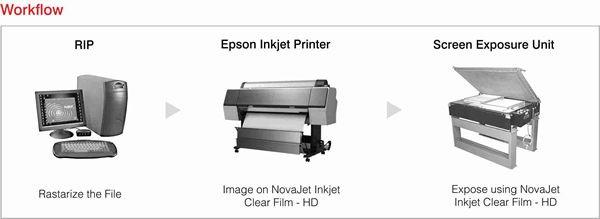Wateproof Inkjet Film for Screen Printing
Available sizes: 13in, 17in, 20in, 24in, 36in
Ask price according to the size
Screen plates-making film is made up of premium high density polyester based (PET) transparent film and specialized layer coating imported from abroad. It owns high definition, water-proof, good ink absorption, high Dmax, and instant drying etc. superiorities. Our film is compatible for standard dye and pigment inks used for inkjet screen printing.- Advanced polyester base material
- Matte coated surface and instant dry
- Superior water-resistance ability
- Accepting both dye and pigment inks
- Excellent high resolution and definition
- Directly factory source and accept OEM service
For Sales Support
Call +91-9872848829Download Brochure
OVERVIEW
Inkjet printers can be used as a replacement for a high priced imagesetters and low quality laser printers. Epson's use a room temperature mechanical, piezo technology of precise electrical pulses that cause the ink reservoir wall in the head to compress, projecting ink through the nozzle. Programmers can also control the exact placement, size, and shape of each dot then shape with the millions of ink droplets they eject in each square inch. For screen printing, we need a one color printer, not an 8 color printer. RIP programmers can increase ink deposit to make the transparent ink designed for CMYK printing of multi-color photographs opaque enough to block UV light. To make screen printing positives with an inkjet printer, you must have an absorbent coating on clear film. Ulano Pigment Inkjet Films are designed to make positives. Dye inks are 100% liquid and can be absorbed by a swellable coating like the gelatin in indirect stencil films. Pigment inks require a micro porous coating with microscopic cavities that can absorb the resin coated pigment particles with natural capillary action.WATERPROOF?
Often, nano porous or micro porous coatings are mistakenly called water proof. If you lick your fingers and pinch a piece of film, you will make one side sticky as it absorbs the moisture with capillary action. Dye inks re-wet and bleed if you get water on them. When the majority of inkjet printers used water based dye ink, suppliers started selling the more expensive micro porous coating as "water proof" to printers who wanted to pay for a safer coating in case their staff spill something on the positive. Pigment Inkjet Films are made to absorb water based inks, but they are not waterproof, rather they are "bleed-resistant". The newest printers use pigment ink instead of dye ink because it resists fading for up to 99 years. This improves family snapshots, but doesn't help the making of UV opaque positives. The nano porous structure of the coating controls the ink spread for image sharpness. Pigment ink particles are coated with a resin so they can be controlled with piezo print heads. Modern inkjet inks used for positives are water based and still need time to evaporate and dry. Ink manufacturers need to balance nozzle maintenance and the desire to have an ink that dries fast after printing, so a positive can be used to make a screen. Glycol or glycerol humectant additives in the water based carrier that are used to to keep the pigments in suspension, retard drying, and prevent nozzle blockage need to evaporate the same way stencil coatings need to dry.Features and Benefits:
- Specialized layer ensures higher Dmax and also facilitates instant drying of ink on the film.
- Optimal coating thickness on the film gives best image results with recommended inkjet printers and media settings.
- Superior water resistance properties ensure protection against accidental loss of image by water.
- Matte grain surface of the film enables good vacuum and excellent image transfer on the plate.
- This also prevents transfer of ink to the screen while exposing.
- Unique coating for single, spot & full-colour reproduction most suitable for various screen applications.
- Excellent dot sharpness and solid black reproduction for superior image quality.
- Totally dry Computer-to-Film-to-Screen process for saving on cost & time.

